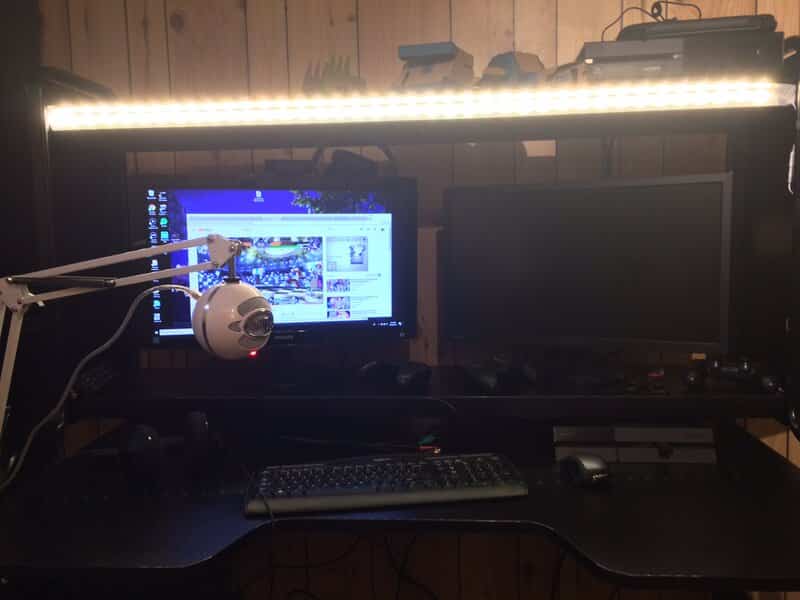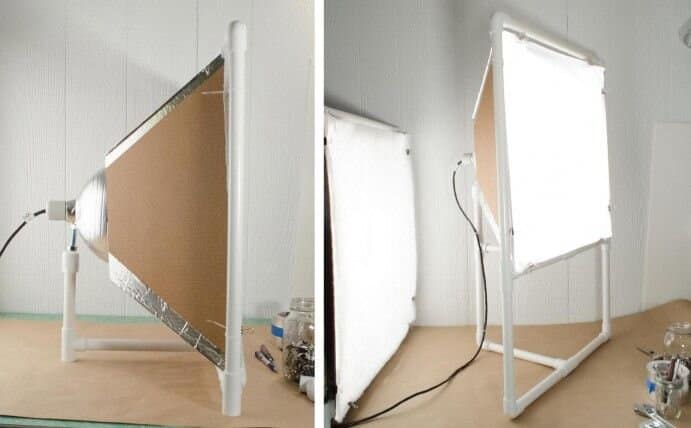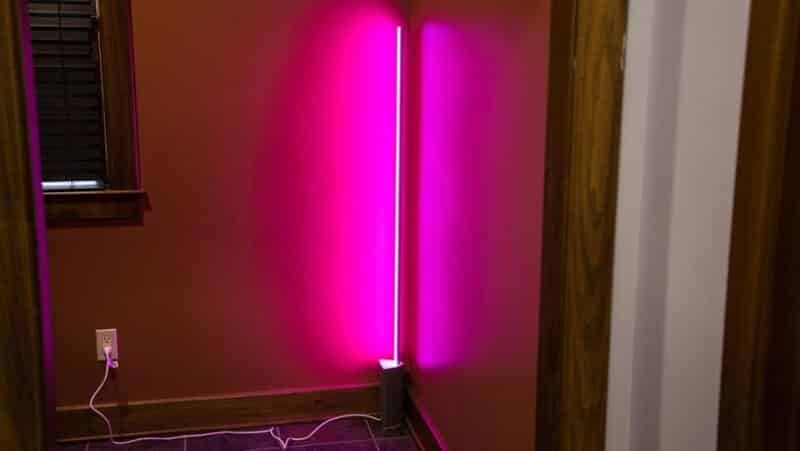One of the things all new streamers forget is to have proper lighting. Professional lighting systems are pretty expensive, but you can do wonders at home with custom-made lighting.
I’ll go through 3 most popular DIY lights that you can probably setup already today!
DIY LED Strip Lighting
Place LED strips with power supply on double-sided adhesive tape that you beforehand placed in your room.
LED Soft Light Panel
You need to make a light head from cardboard, then make a diffuser from two sheets of parchment paper and soldering iron, and for the end, make a light stand from cardboard, as well.
DIY Floor Light
Acquire the clamp light and the tripod, attach the clamp light to the tripod, strengthen it with a spring clamp, screw the light bulb in and try it out.
Table of Contents
3 Easy DIY Streaming Lights
LED Strips, Soft Panels, and Floor Light
There are many different DIY lighting methods you can find on the web, but we’ve decided to walk you through the 3 easiest ways you can create your homemade lighting.
For each DIY light, we’ll cover which supplies you’ll need, how to make them, and what they are best for.
Let’s see how you can save your hard earned money and have some fun while making your DIY video lighting!
1. DIY LED Strip Lighting
For the first method, we’ve chosen the simplest and easiest solution if you need some basic lighting for your streams.
For this LED strip lighting you’ll need:
- LED strips
- LED power supply
- Parchment paper
- Double-sided adhesive tape
Your LED strip lights should be around 3000 K lumen, and depending on what temperature of lighting you prefer, you can use either neutral white or cool white.
As far as LED power supplies are concerned, many LED strip lighting kits already come with a power supply, but if you find one that doesn’t, power supplies are often quite cheap.

Parchment paper will assist you in diffusing the light a bit, however, if you find LED strip lights that have brightness adjustability then you don’t need them.
And lastly, you need double-sided tape to fix the lights in a certain area.
The total cost of this DIY light should be around 20$ and you don’t need more than 10 minutes to finish your DIY project
How to Make It?
First, you’ll need to use double-sided tape and place it across an area you want your LED strip to be.
It can be placed on the sides or bottom of your desk, on your wall, on the edge of your bookshelf if it’s mounted above your desk, and so on. The choice is yours.
A great idea is to set up your camera and start recording and when you start mounting the lights and turning them on, check and see how it looks on camera. This will make it easier for you to make any simple adjustments.
Once you’re happy with the placement of your tape, you need to stick the back of the LED strips onto it. Do this carefully and as precisely as you can as you want the LED lights to be in one or two even lines.
Then, use small bits of tape and secure the lights in place by tapping the small gaps between each small LED light.
If you want dimmer lighting, this is the time to use strips of parchment paper and then tape them over the lights.
When you’re done, just plug the strip into the power adapter and you’re good to go.
See? It’s cheap, quick, and easy.
2. DIY LED Soft Light Panel
The next light you can make at home is actually kind of a mix of a DIY soft light and a light panel. It may take more time to make it than the previous method, but you’ll be proud of yourself once you’re done.
The things you’ll need to create this include:
- LED strip lights
- LED power supply
- Parchment paper
- A piece of thick cardboard (12”x12”/30cmx30cm)
- Aluminum foil
- Skewers
- Binder clips
- Hot glue gun
- Soldering iron
- Electrical tape
- Exacto knife
- Ruler
- Wiring
Most of this stuff you should already have at home, except the soldering iron or the glue gun, so if you can borrow them from a friend, then you won’t have to buy them.
How to Make It?
There are actually 3 steps to the whole process, so we’ll walk you through each one thoroughly.

#1 Step – Making the Light Head
In the first step of making your DIY soft light, you need to take a piece of cardboard that is roughly 12” by 12”, and you want to make a square around the perimeter of the cardboard which is about 2” wide. Use your ruler to measure and a pencil to make the lines.
Then, you want to make 10mm diagonal notches on each corner so you can kind of make a box-shaped light head.
Once you cut out your notches, use your knife to gently score the creases where the cardboard will bend as it will be easier for you to assemble it.
Use your glue gun to glue the notches together and your light head should start to form an open box shape with bent sides.
Once that is done, you want to make the light reflect, and the best way to do this is to use aluminum foil. Take a piece of aluminum foil that’s a bit larger than your light and glue it on with a hot glue gun.
You want to make as least creases as possible so try to iron the foil a bit with a ruler but just be careful not to rip the foil.
At the very end, punch a hole through one of the corners big enough so your power cable can fit through.
Now you’re ready to start gluing your LED strips, which takes us to step #2.
#2 Step – Preparing the LEDs, Soldering, and Making the Diffuser
So it’s time to attach the LED strips to your improvised light head. Grab your LED strip and cut it into 9 strips with around 9 LEDs apart each.
You should also put them in a sort of zig-zag pattern because it will be easier to solder them together.
When you put your LED strips in order and glue them with the glue gun, you’re now ready to do a bit of soldering.
If you don’t have much experience in soldering, try out your skills with a small piece of LED strip before you start soldering your DIY light.
Use your soldering iron and solder and just put a dot on each of the pads on the LED strips and then use your wiring to connect them.
It’s quite simple – positive to positive and negative to negative. Cut off each positive and negative wiring into small wires and create a simple circuit.
At the end of the last strip, you should solder your power cable which goes into the power supply. Check to see if it lights up and if it doesn’t check your wiring again.
Now that the hard stuff is done, all you have left is to make a diffuser and put it on the light head. Use 2 sheets of parchment paper the size of your light and tape them just on two sides so you can easily remove them if needed.
That’s it for step #2, so let’s go to the final step which includes making a stand for your light. It should be a breeze.
#3 Step – Making a Light Stand
The last step is quite easy. Get a piece of cardboard, approximately 10″ in length, and cut out a “T” shape on both sides so that when you fold it, you once again get a “T” shape.
Then, glue the bottom of your “T” cardboard and leave the “wings” in between which you will take a piece of skewer and glue. This will make a hinge mechanism.
Make sure that enough of the skewer is hanging from the cardboard because you need to tape the end of the skewer to one end of the binder clip. Because the binder clip is a bit tilted, you’ll get an angled DIY continuous light softbox.
As this is a tabletop light, it can be a great light you can put on your desk, or you can even use the binder clip to clip it onto the side of the desk or a shelf.
3. DIY Floor Light
The last on our list is of course a DIY floor light because no lighting setup for streaming is complete without one. We are going to recreate a studio light and all that for half the price.
The great thing is that this isn’t that big of a project so you won’t need to spend so much time as with the previous light.

These are the things you need:
- Clamp light
- Tripod
- LED bulb
- Spring clamp
- Parchment paper
- Tape
The clamp light and the tripod are the most expensive things on the list, but you’re still going to save a lot of money and have a great lamp that’s quite powerful.
Let’s see how to make it!
How to Make it?
To make this video lighting DIY with a floor tripod, first, you get the clamp light that you prefer. Try to get at least a medium or large-sized clamp light because they’ll shine much brighter than a small one.
Then, you need to find the right bulb – typically it should be around 100W. The color of the light depends on your liking but if you want a safe choice then go with the daylight bulbs.
To attach the clamp light to the tripod, place the clamp at the correct height. If the tripod has a phone stand or a camera mount, place the clamp of the clamp light below the mount.
Then, use the spring clamp and clamp down the clamp of the light clamp. That’s a lot of clamps. Jokes aside, this way, the tension between the two clamps will hold into place and your light won’t budge.
And as you can see, you’re all done. Just screw the light bulb in and try it out, and if you want to diffuse the light, just cut out a circle shape from the parchment paper and tape it on the sides of the light head.
So as you can see, it’s quick and easy and it’s also quite a cheap method to make a studio light. This light is best if you need a backlight or a fill light.
Things to Consider When Making Your DIY Stream Lighting
Now that you know how to make a softbox light, floor light, or even to glue simple LED strips to your desk, there are a few things you should consider before you start making your DIY streaming lights.
1. Quality
Of course, you won’t get the best quality lights if you go DIY, but you can still make a light that will fit your needs.
If you’re already thinking of making DIY lights, then you’re certainly trying to spend as little as possible so the quality of the lighting isn’t your biggest concern.
And this isn’t anything to be ashamed of, as making DIY lights is a fun project and you don’t actually need the best quality lights when you start out.
So if you’re not worried about the quality of the lights, but just want to have some source of lighting, then one of these DIY lights might be your next afternoon project.
2. Budget
It is actually possible to get cheap lighting for streaming even if you’re on a budget. You can get away with a 25$ streaming light that’s not that bad actually.
However, you can also make your own light for the same price as we’ve shown you in our guide above.
So it’s up to you and your budget which path you’ll go on. Just remember, it is way more fun to make your DIY light and you’ll be proud of yourself once you’re done.
3. Adjustability
The one con of making your DIY lights is that they won’t be as adjustable as if you were to buy regular streaming lights.
Of course, you can improvise, and make them more adjustable, for example making your own filters and diffusers, but in the end, you won’t have all the features many streaming lights have.
So in the end, DIY lights are going to be appealing to a specific crowd of people who like to make things with their hands and are creative enough to make things work.
If you fall in this group, then you should definitely try to make your own lighting.
Conclusion
We hope that this DIY guide was helpful and that you’re at least intrigued by what you can make with your hands.
Of course, if you find a way to make lights differently, or just want to improve our method, we’re more than happy to know that we’ve inspired you.
Have fun while making your DIY lights!
